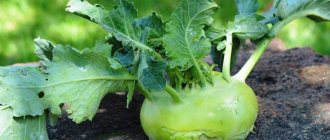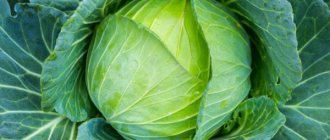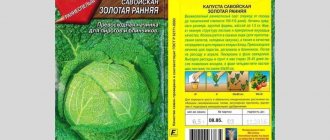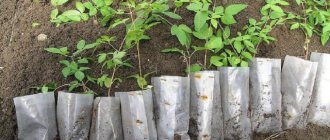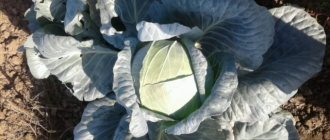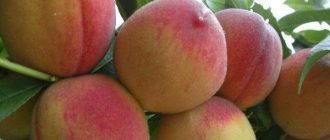Red cabbage - description of the species
Red cabbage bears fruit with heads of purple, mostly red, hues, which are imparted by the natural enzyme anthocyanin. They are dense and elastic to the touch, and the inner leaves are closely adjacent to each other and retain their color when cut.
The harvesting period divides varieties into early, middle and late (up to 160 days). Mainly the latter, since its biological maturation time is longer than that of the “white” one. The average yield and juiciness of red cabbage leaves is lower, but it is more resistant to diseases and less sensitive to the effects of garden pests and cold weather, and is noticeably richer in nutrients.
Vegetables are often used to prepare fresh salads and side dishes, but the nutritional characteristics of some varieties allow cabbage to be successfully pickled and fermented.
Harvesting time and storage methods for red cabbage
Harvesting of red cabbage begins from August to October, depending on the variety. Early varieties will be stored for only two to three months, while later varieties will last until spring and even summer. It is very important to harvest on time, in dry, cool weather and with an eye to the lunar calendar. Red cabbage tolerates low temperatures perfectly and in the fall it is worth keeping it in the beds longer so that the heads of cabbage become more juicy and tasty. But you should not allow the forks to freeze, since such cabbage will not be stored well; slight frosts are acceptable provided that the heads of cabbage are thawed while still standing.
Video: secrets of red cabbage
When harvesting cabbage, you need to leave a few top leaves and a stump at least 3 cm long. The best temperature for storing cabbage in the cellar is 0 ° C, humidity - 90–95%. It is not worth placing different varieties together, because the shelf life indicators of early, middle and late varieties are different. Also, the heads of cabbage should not touch each other. Our harvest can be stored on shelves, racks, in boxes, hanging or buried. You can wrap the forks in cling film, paper, or place them in plastic bags.
We pull out cabbage intended for storage along with the roots and hang it on hooks in the cellar. If you need to store cabbage for a short time, you can cut off the root, wrap the forks in paper and place it again in the cellar on a shelf. When using red cabbage for salads, I cut off part of the head and place the rest in a plastic bag in the refrigerator, where it feels great for a long time.
Video: 10 ways to store cabbage
Beneficial properties of red cabbage
The increased content of potassium, a set of vitamins B and PP, ascorbic acid, carotene, and organic enzymes are responsible for the special usefulness of red cabbage. The vegetable is low in calories, widely used in dietary and healthy nutrition, and is good for the gastrointestinal tract.
Anthocyanins remove toxins and heavy metals (radiation) from the body, phytoncides fight infectious diseases (including tuberculosis bacillus). Eating cabbage has a beneficial effect on a person’s general condition, freshness and elasticity of the skin, and the cardiovascular system.
Features of agricultural technology
Cultivating red cabbage is similar to white cabbage, and the first step is preparing seedlings in greenhouses (if desired, in protected open ground). Seeds are planted in the ground at a depth of 1-1.5 centimeters, at a distance of 8-10 centimeters. The ideal temperature for growth is 15-18 degrees Celsius. It is transferred to open soil after 5-6 leaves appear (after about 40-50 days).
Red cabbage is also planted by seed, but this requires preparation (hardening) of the seeds. They are placed in 50-degree water for 20 minutes, then cooled in cold water for a couple of minutes. It would be a good idea to place them in a nutrient solution (1 teaspoon of nitrophoska per liter of boiled water, rinse and leave in the refrigerator for 24 hours).
Important! The plot for cabbage must be prepared in the fall, observing crop rotation (cabbage should not grow on it for 3-4 years, it’s good if tomatoes, potatoes, cucumbers, and legumes were previously cultivated here). The vegetable loves “light”, “fluffy”, oxygen-rich and well-fertilized soil, so you need to dig it up for the first time in the fall, adding fertilizers (mineral, manure, compost, wood ash). The same must be done in the spring before planting, and in the future the soil will need to be regularly loosened and fertilized with fertilizers.
Cabbage intended for long-term storage (the optimal storage temperature is about 0 degrees) is best harvested in October, preferably in dry weather. The more frost-resistant species tolerates light frosts, but you should be wary of frostbite on the heads, which may cause further problems with storage.
Features of planting shoots
Proper cultivation of red cabbage requires compliance with the following planting and care requirements:
- Before sowing, seeds must be prepared for planting in the ground, treated with potassium permanganate and dried.
- Soil containing peat and turf soil in equal parts is poured into the container.
- Before the disappearances appear, the optimal temperature should be 16-20 degrees. A week later, when the first leaves appear, they reduce it to 12-15 degrees.
- The seedlings are ready for transplanting at the end of May. The seedling with 5-6 leaves that have formed is carefully removed along with the soil so as not to damage the root system.
The finished seedlings are transplanted to the plantation.
Conditions for culture growth
The growth rate of a vegetable is affected by lighting, soil fertilization and transplantation features:
- red cabbage grows well in light, loose soil;
- The ideal place is a garden bed with good lighting;
- the soil for future cabbage cultivation is prepared in the fall by adding fertilizers;
- Transplantation of seedlings is carried out in the morning.
When planting a plant, add fertilizer to the hole and fill it with a small amount of water. The earth around becomes a little compacted and moistened.
Planting and caring for red cabbage in open ground
Strengthened seedlings of early ripening varieties (70-90 days of ripening) are transferred to open ground starting in April (the ten-day period depends on the climate in a particular year). When planting, a hole pattern of 70 (60) by 40 (30) centimeters is used. Late-ripening varieties (130-160 days) and mid-ripening (100-120 days) are transferred in April-May, planted at the rate of 70 (60) by 60 (50) centimeters.
For red cabbage seedlings, holes 15 cm deep are prepared, which are spilled with a small amount of water (preferably heated in the sun) and a little fertilizer is added (mineral, potassium, urea, ammonium nitrate). After planting, be sure to water it with a couple of liters of water, preferably warm, loosen the soil around the plant and hill it up a little. For the first 5-7 days, seedlings require daily watering.
Attention! After 7-10 days, it is necessary to add the first “feeding” (10 grams of urea per bush), and before the rows close, add nitrophoska (15-20 grams per plant). It is also recommended to fertilize the soil with potassium and superphosphate (two teaspoons per “square” during the period of active leaf growth), and 4-5 spoons during the formation of heads of cabbage.
Planting by seed method is carried out to a depth of about 4-5 centimeters, according to a scheme similar to the “seedling” method. 4 seeds are dropped into the hole and sprinkled with soil mixed with humus, peat or wood ash. Thinning of the rows can be done after 2-3 leaves appear on the plants, and when they grow to 15 centimeters, leave the strongest shoot. Be sure to hill up and water.
Caring for cabbage during growth requires regular loosening of the soil and maintaining its humidity (at 70-80%, more is harmful), slight hilling, fertilizing the soil 2-3 times (but not overfeeding with nitrogen fertilizers) and destroying weeds and pests.
Red cabbage Garancy F1: characteristics (video)
The garden crop prefers sunny areas, since in the shade the foliage acquires a greenish-violet color, and the head of cabbage becomes loose and forms at a later date. Cabbage of this type has a fairly high demand for water, but does not tolerate waterlogging or stagnation of moisture very well.
The soil should be light and loose, fairly fertile, with a pH in the range of 5.5-7.0. The crop is characterized by its responsiveness to the application of mineral and organic fertilizers, therefore, at the stage of intensive leaf growth, fertilizers with a high nitrogen content are used, and at the stage of head growth, it is preferable to use phosphorus-potassium fertilizers. Excessive application of nitrogen-containing fertilizers significantly delays the formation of heads of cabbage. Also, caring for red cabbage necessarily includes timely weeding, as well as loosening the soil. During the third loosening, the plants should be hilled up.
How does red cabbage grow?
Red cabbage belongs to biennial plants, therefore it bears fruit in the first year, and in the next year it forms round, brown-brown seeds that ripen in 8-12 cm pods. The branched and strong root system extends into a short root stem, a “stem”; the internodes are small. Round and oval heads of cabbage (sometimes cone-shaped) are formed on it, surrounded by outer leaves.
The period of growth and ripening of red cabbage depends on the specific variety, and on average is longer than that of white cabbage. The heads of cabbage are formed smaller in size, but more elastic and dense, ranging from 1-4 kilograms. The plant loves moist soil, but not “water meadows,” and sunlight, the lack of which affects the speed of ripening, the quality of the vegetable and the size of the harvest.
Contraindications for use
Red cabbage is generally not harmful to health when consumed in moderation, but in some cases, it may be contraindicated.
It is not recommended to use this variety in the following cases:
- individual intolerance to the substances contained in the composition;
- diseases of the pancreas and stomach;
- diseases of the duodenum;
- high blood pressure.
If you have such diseases, it is strictly not recommended to consume raw cabbage leaves; the same restriction applies to its juice.
Heat-treated heads of cabbage, for example, when stewed, pose a slightly less health hazard.
Mothers during lactation should also treat it with caution, because... some components of this vegetable can cause colic in infants.
The best varieties of red cabbage
Years of cultivation have allowed agronomists and gardeners to identify the best varieties of red cabbage, each of which has its own merits. These include:
Calibros
A variety of mid-season red cabbage (also called calibos), which tolerates cool weather and moist soil well, ripening in 100-110 days. The pride of the Czech selection. The heads of cabbage grow cone-shaped, purple and red-violet in color, weighing up to 2 kilograms.
It is distinguished by the tenderness, sweetness and juiciness of the leaves, excellent taste, and is used in cooking in fresh and pickled form. High yield is combined with the ability to be stored for a long time (up to 4 months).
Pallet
It is a late-ripening species, with a ripening period of 140-150 days, and is resistant to weather fluctuations. The shape of the heads of cabbage is round, the color is purple with reddish hues, the weight is 1.3-1.8 kilograms, the shelf life is more than 4 months. Cabbage leaves are low-juicy; culinary experts use them fresh or after processing.
Stone head
The mid-ripening variety (about 125 days) is distinguished by increased productivity, resistance to traditional cabbage diseases and the large weight of round-oval heads of bright purple color - up to 3.5 kg. Can easily be transported and is well preserved.
Nurima F1
This early ripening variety comes from Holland and the F stands for hybrid. It matures in 70-80 days and can be planted from March until June. The small size of the plant, with purple round elastic heads (weighing 1-2 kg), makes it easy to use covering materials. Resistant to significant climate changes, not afraid of diseases and garden pests.
Red cabbage recipes
You can get the benefits for your body from red cabbage without harming your body using various dishes.
Salad with cucumbers and cabbage cheese:
- The cheese is grated on a coarse grater, the cabbage is finely chopped.
- Add cucumbers cut into strips.
- Finely chop the greens and add to the salad.
- Season the dish with mayonnaise or sour cream, add salt and pepper to taste.
The ratio of vegetables to cheese varies according to taste. If desired, you can add hard-boiled eggs.
Salad with squid, corn, cucumbers:
- 300 g of squid are boiled until tender.
- 1 carrot grated on a coarse grater.
- 1 medium-sized cucumber, coarsely chopped.
- Mix everything in a salad bowl.
- Add 250 g of finely shredded red cabbage.
- Add 150 g of canned corn.
- Season the salad with mayonnaise, salt, and chopped herbs to taste.
If desired, it is permissible to replace corn with green peas; it is permissible not to add carrots, increasing the amount of cabbage and cucumbers.
The easiest way is to prepare a salad from equal amounts of the purple and white varieties, pouring olive oil over the dish. In this case, you need to mash the vegetables properly so that they release juice and become softer.
With salad recipes, it is permissible to improvise, add ingredients to taste, change the ratio. The only thing that should not be allowed when preparing a dish is an excess of an ingredient that will interrupt the taste of the rest.
Early varieties of red cabbage
In terms of growth time, some early-ripening varieties of red cabbage can be compared with white cabbage, up to harvesting two harvests per season. Among them:
You may be interested in: Dates for planting cauliflower seedlings in 2021 according to the moon Favorable days for broccoli for seedlings in 2021 Planting Chinese cabbage for seedlings in 2021 according to the lunar calendar
Primero F1
Round, densely structured vegetables grow in 75-80 days to 2-2.5 kilograms. The heads of cabbage are purple when cut, are not subject to cracking, and “stand” well in the field for a long time. The hybrid variety is not susceptible to fusarium and bears fruit abundantly. The leaves are covered with a waxy coating, without bitterness, and are used fresh and in vegetable salads.
Langedijker early
It is characterized by small leaf rosette sizes and a short ripening period (early ripening variety). Red and purple heads of cabbage are medium in size, round-oval, medium elastic, up to 2 kg in weight. Used fresh in the kitchen.
Topaz
The variety ripens in 95-110 days and is also suitable for growing in autumn. Loves light and moisture, resistant to cold. The heads of cabbage are round in shape, rich purple in color, and have high taste. Suitable for canning and salads.
Medium varieties of red cabbage
The 100-day, short ripening period of red cabbage makes its mid-season varieties the most popular among gardeners. Including:
Autoro F1
The variety is cultivated as a hybrid, ripens in about 120 days, the heads of cabbage grow slightly oval in shape, up to 2 kilograms, elastic in structure with thin leaves. Productivity is high and can be stored for 4 months. When growing, you should especially be wary of clubroot disease. Vegetables are eaten fresh and suitable for processing.
Worox F1
The hybrid grows in 110-120 days, bearing fruit in elastic heads weighing up to 3 kg. The leaves are purple in color, with a noticeable waxy coating. Productivity is low, suitable for salads.
Gako
Ripening occurs within 110-120 days after transferring the seedlings to open ground. The heads of cabbage have a violet-gray color with a shine, and weigh up to 3 kilograms. Freshly picked vegetables are a little bitter, but this goes away after a short period of storage, which can last up to six months.
Mikhnevskaya
The Russian variety bears fruit in 110-120 days, the heads of cabbage are red-violet in color, maximum 3 kilograms. Productivity is average, long storage time. A waxy coating is clearly visible on cabbage leaves, and their taste allows them to be used fresh or, if desired, canned.
Late varieties of red cabbage
Late-ripening red cabbage is distinguished by its ability to be stored for a long time and the large size of its heads. Among the varieties stand out:
Rodima F1
It ripens in a period of 120 to 140 days, producing dark purple-colored heads weighing up to 4 kilograms, with excellent taste characteristics. Vegetables are immune to cracking, can be stored until next summer, and are preferably eaten fresh.
Langedijker late
A high-yielding variety that produces 3-kilogram dark purple giant heads of cabbage in 150-160 days. They have a dense structure and are round. Recommended for use in salads, easily stored and transported.
Recommendations for eating red cabbage
In addition to the benefits, the red cabbage variety of the plant causes minor harm. Therefore, before use, you should check if there are any of the contraindications:
- stomach ulcer;
- allergies;
- acute phase of gastrointestinal diseases;
- dysfunction of the thyroid gland.
When there are no contraindications, eating red cabbage is acceptable in the same quantities as other foods. The benefit in this case will significantly outweigh the potential harm. The properties of the red cabbage variety are best revealed in salads and pickled form.
Popular varieties of red cabbage
Domestic gardeners have chosen a number of varieties of red cabbage, which can be considered the most popular. Among them are vegetables of different ripening and storage periods, sizes and taste characteristics.
Vanguard F1
The variety is mid-season and produces heads of cabbage with good taste. They are oval, dense, purple in cross section and with blue-green leaves covered with a waxy coating. Red cabbage grows up to a little over 2 kilograms.
Anthracite F1
Also a representative of the mid-season variety, ripening in 120-130 days. The heads of cabbage are bright purple in color, weighing up to 2.5 kg, round in shape, with succulent leaves. A high-yielding variety, it is stored until winter and is preferred fresh in cooking.
Boxer
Early ripening cabbage, with red-violet heads, about 1.5 kilograms, and a “silver” waxy coating on the leaves. Grown for seasonal consumption.
Drumond
Belongs to early ripening varieties. The heads of cabbage are light purple in color, small, about 1.5-2 kilograms. The yield is stable; due to its taste, it is also used in canning.
Stone head 447
It is considered mid-season, ripening in 110-130 days. The heads of cabbage are purple-red, grow small - up to 1.5-2 kilograms, and are not resistant to cracking. Doesn't keep well, but tastes good when fresh.
Kissendrup
An early ripening variety with large, 2-kilogram heads of dark red color. Short storage period, cultivated for direct use.
Summer debut
Also early-ripening cabbage, with small, up to 1.5 kilograms, purple heads of cabbage. Resistant to both cold and heat.
Lyudmila
Early ripening, with excellent taste. The heads of cabbage grow up to 2 kilograms, are purple when cut, and have green leaves.
Maxila
Late-ripening cabbage, with a storage period until March of the new year. Heads of cabbage up to 1.5 kilograms grow in 150-160 days.
Mars
Mid-season variety, ripens in 110 days. The heads of cabbage are dark purple, from 1 to 2 kilograms. Cabbage is valued for its taste and range of beneficial microelements.
Reviews
There are two types of reviews about red cabbage - from gardeners who cultivate it, and cooks who use the vegetable in the kitchen. The first talk about the growing process, complaining about the difficulties at the beginning, but agree that the attention paid is rewarded with abundant and tasty harvests. The latter only praise it, boasting about the number of recipes with it.
Both categories include the possibility of long-term storage and a lot of vitamins that do not “disappear” during the process as the main advantages of red cabbage. Thus, even in the depths of winter, you can have a fresh and healthy red cabbage salad on the table.
Possible contraindications
Best materials of the month
- Coronaviruses: SARS-CoV-2 (COVID-19)
- Antibiotics for the prevention and treatment of COVID-19: how effective are they?
- The most common "office" diseases
- Does vodka kill coronavirus?
- How to stay alive on our roads?
Some people may experience flatulence and indigestion when consuming cabbage. But if dysfunction in the stomach is caused by white cabbage, this does not mean that the same result will be from red cabbage or broccoli. By the way, Indian Ayurveda, to facilitate the digestion of cabbage, recommends cooking it with garlic, onion or ginger in olive oil, rich in vitamin E and fatty acids. But the combination of several varieties of cabbage in one dish can increase the unpleasant effect in the form of indigestion or flatulence. Also, raw cabbage is contraindicated for duodenal ulcers.
It is also important to know that red cabbage is on the list of goitrogenic foods, the consumption of which inhibits the body’s absorption of iodine. And this is fraught with the development of iodine deficiency.
Like other cruciferous vegetables, red cabbage has the ability to absorb purines from the soil, which, when entering the human body, are converted into uric acid. Excessive consumption of vegetables can be dangerous for people with kidney disease, since their bodies are not able to fully remove excess uric acid. And this is a direct path to the development of gout.
